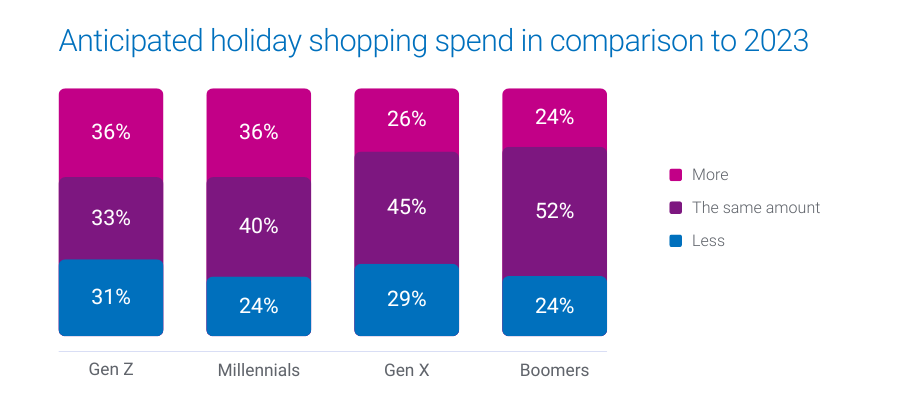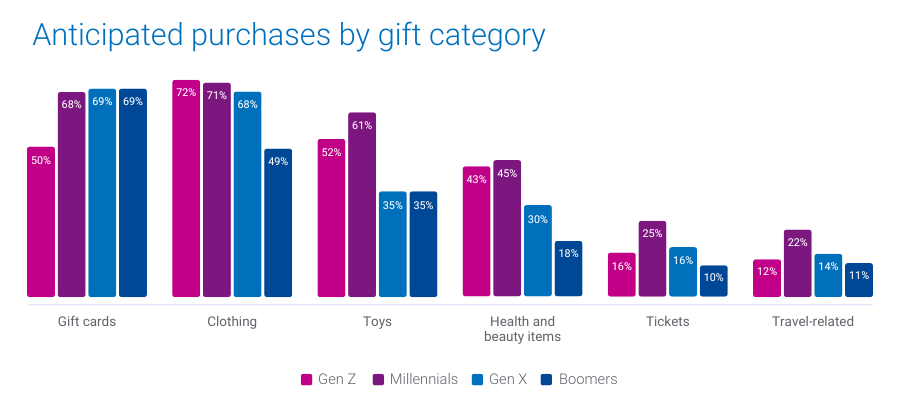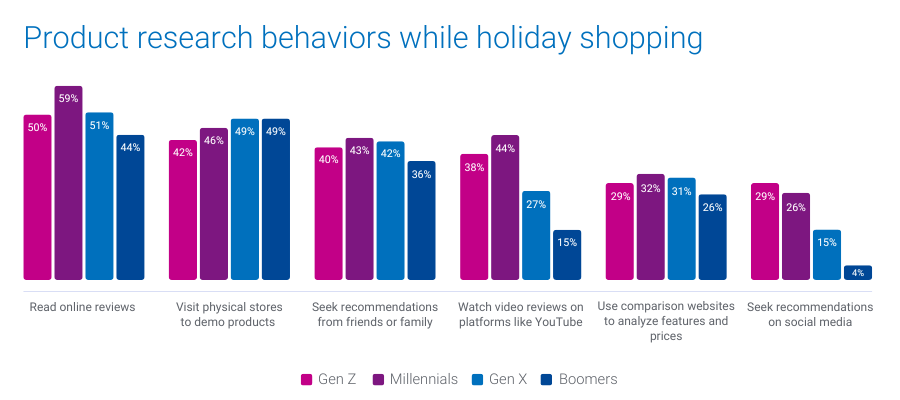
The holiday season is almost here, and knowing how each generation plans to shop can give your holiday advertising campaigns the edge you need. Our recent survey of 1,000 U.S. consumers reveals 2024 holiday shopping trends for each generation and key insights into their anticipated spending levels, preferred shopping categories, and how they look for gift ideas.
In this blog post, we’ll explore three 2024 holiday shopping trends across generations:
- Projected consumer spending
- Top categories on shoppers’ lists
- Preferred channels for researching gifts
1. Projected consumer spending
Over 1 in 3 Gen Z and Millennials are gearing up to increase their holiday budgets this year, while Gen X and Boomers are likelier to stick to last year’s budget.
- 36% of Millennials and Gen Z plan to spend more this holiday season
- 45% of Gen X and 52% of Boomers expect their spending to remain consistent with last year

What this means for marketers
These insights highlight the importance of tailoring your messaging. For Gen Z and Millennials, emphasize value and unique offerings that justify increased spending. For Gen X and Boomers, focus on trust and reliability, reinforcing their confidence in your brand.
How Experian can help you target these audiences
Experian’s custom and syndicated audience segments, including Holiday Shopper High Spenders and Holiday Shopper Moderate Spenders, enable you to connect with these diverse consumer groups. Our audiences are available on-the-shelf of leading ad platforms to help you reach people across social, TV, and mobile.
The election effect
U.S. holiday retail sales saw 4.1% YoY growth in 2016 and 8.3% YoY growth in 2020 following presidential elections. There’s a chance that holiday spending increases after the 2024 election, regardless of the outcome. Experian has 240+ politically relevant audiences that you can activate across major ad platforms ahead of the upcoming election.
2. Top categories on shoppers’ lists
Different generations have distinct preferences when it comes to what they plan to buy. Gift cards top the list for Gen X and Boomers, while Gen Z leans toward clothing. Millennials are looking to splurge on toys, electronics, and experiences.
- 69% of Boomers and Gen X plan to purchase gift cards
- 72% of Gen Z will buy clothing
- 45% of Millennials will buy health and beauty items
- 25% of Millennials will buy tickets and 22% of Millennials will buy experiences

What this means for marketers
Align your product offerings and promotions with each generation’s preferences to capture their attention. For example, highlighting versatile gift cards may resonate more with older generations, while showcasing trendy apparel and tech gadgets will appeal to younger consumers.
How Experian can help you target these shoppers
We offer audience segments like Holiday Shoppers: Apparel, Cosmetics & Beauty Spenders, and Toys Shoppers that you can activate to connect with consumers primed to purchase in these categories.
We recently released 19 new holiday shopping audiences we recommend targeting to drive engagement and conversions. Download our audience recommendations here.
3. Preferred channels for researching gift ideas
When it comes to finding the perfect gifts, Gen Z turns to social media, while Millennials prefer online reviews and video content. Boomers and Gen X are more inclined to visit physical stores for hands-on product evaluations.
- 29% of Gen Z and 26% of Millennials will look for gift ideas on social media
- 44% of Millennials will rely on video reviews and product demos on platforms like YouTube
- 49% of Gen X and Boomers plan to visit physical stores to evaluate products in person

What this means for marketers
Understanding where each generation looks for inspiration can guide your content and ad placement strategy. To engage Gen Z, focus on social media campaigns and influencer partnerships. For Millennials, consider investing in video content and reviews. For older generations, ensure your in-store experience is optimized to convert browsing into purchases.
How Experian can help you engage these shoppers
Our TrueTouchTM audiences can help you pair the perfect messaging styles with the right channels and calls to action. Our Social media channel and content engagement audiences can help you reach Gen Z who are likely to be active users on major social platforms and are Black Friday shoppers. For a full list of Experian’s syndicated audiences and activation destinations, download our syndicated audiences guide.
Download our report for five 2024 holiday shopping trends by generation
Understanding 2024 holiday shopping trends by generation can help you tailor your targeting, messaging, media planning, and creative based on the generation you’re targeting.
In addition to the insights covered here, download our 2024 Holiday spending trends and insights report to learn:
- When consumers plan to shop (hint: they’re already shopping)
- Where they plan to shop (online vs. in-store)
Download our full report to access all five of our predictions by generation, so you can address the diverse needs of this year’s holiday shoppers.
When you work with Experian for your holiday shopping campaigns, you’re getting:
- Accurate consumer insights: Better understand your customers’ behavioral and demographic attributes with our #1 ranked data covering the full U.S. population.
- Signal-agnostic identity solutions: Our deep understanding of people in the offline and digital worlds provides you with a persistent linkage of personally identifiable information (PII) data and digital IDs, ensuring you accurate cross-device targeting, addressability and measurement.
- Secure connectivity: Bring data and identity to life in a way that meets your needs by securely sharing data between partners, utilizing the integrations we have across the ecosystem, and using our marketing data in flexible ways.
Make the most of this holiday shopping season with Experian. Contact us today to get started.
Source
Online survey conducted in June, 2024 among n=1,000 U.S. adults 18+. Sample balanced to look like the general population on key demographics (age, gender, household income, ethnicity, and region).
Latest posts

As marketers, we all want to better leverage data to understand our customer and provide them with the best possible experience. It not only better serves our clients, but is ultimately more profitable for the company. But most of us struggle with large volumes of data, with no idea how to best use it. There are many factors that play into this problem. For most organizations, data is spread out across multiple systems with no consistent data management strategy. That means that as marketers, when we get the data, it comes in a wide variety of forms. The standardization could be different, customers could be missing certain record fields, purchase history could be divided into different accounts…you get the picture. This disparity makes it difficult for us to get any sort of insight from the information. How can we leverage data if it is inaccurate, incomplete and not accessible? Experian Data Quality recently completed a survey of over 250 chief information officers (CIOs) and found that they too are struggling to leverage data. Four out of five see data as a valuable asset that is not being fully utilized within the organization. In speaking with the CIOs, some of the biggest challenges aren’t just about technology, but rather organizational structure and company culture. Sixty-eight percent of CIOs struggle to find stakeholders who take anything other than a siloed view of data management. In addition, 70 percent of respondents say they struggle to implement data-driven decision making because no one seems to own the process. To improve data insight, organizations need to improve the structure around data management. This is where the chief data officer (CDO) comes into play. The chief data officer is a growing c-suite position that is getting more and more popular. Most of the CIOs we spoke with that had a CDO said the role had only been created in the last six months. The reasons companies are looking to put a CDO in place are all related to improving access and insight from data. CDOs are there to: Reduce risk around data-driven projects Curb costs from poor quality data Handle increasing data governance pressures As this role continues to grow, it is going to have a big impact not only on marketing, but also the organization as a whole. With that in mind, join us for a webinar on Tuesday, August 18th at 2 PM EST to talk about the emergence of the chief data officer. We’ll discuss data as an untapped resource, how the role is changing organizations and how to ensure your organization is ready for the shift that this new role brings. Register today!

There is much to be said about the differences between college-age consumers (19- to 21-year-olds) today and their counterparts five years ago. As many marketers recognize, young-adult consumers cannot be targeted based solely on generalizations and assumptions. To accurately and respectfully capitalize on this segment’s buying power, marketers need to understand how their spending patterns have changed in recent years and how to earn a slice of the group’s spend. Accounting for inflation, 19- to 21-year-olds are making more money than young adults did five years ago. Their pay has increased by 20 percent, and, interestingly, their spending has increased by 30 percent. So where are they spending this money? 1. Dressing for success According to Census Area Projected Estimates (CAPE) of expenditure data from Experian Marketing Services, both men and women in this age group are filling their closets with about 35 percent more professional attire — shoes included. This has brought 2015’s average spend up to $22,859 per year per household for college-age women and $11,196 per household for college-age men. This rise in spending on professional wardrobe could be attributed to more professional entry-level job expectations or a possible shift in technical trade positions to business professional positions. CAPE data also reveals a 70 percent increase in memberships to networking and recreational clubs. This increasingly professional outlook among college age consumers requires confidence and the right ensemble to proclaim success. Key takeaway: Position products and services to appeal to this career-minded consumer who is aiming to look the part. 2. “Go with the flow” What kinds of messages resonate with these individuals? According to TrueTouchSM data from Experian, college-age consumers can be best engaged when marketers appeal to them using a “Go with the flow” marketing message. “Go with the flow” has consistently ranked as the top motivating marketing message for college-age individuals in the study. The second and third most resonating marketing messages for this market are “Never show up empty handed” and “Work hard, play hard.” “Go with the flow” means this market has a live-and-let-live outlook on life. Brands who employ a similar outlook, don’t take themselves too seriously and extend no-risk offers may have a better chance to engage this cohort. Key takeaway: If marketers tailor messages around these motivating philosophies, they may have a better chance of earning this market’s business. 3. Offline entertainment For marketers in the retail industry, particularly those with clothing or supplies fit for the outdoors, be aware that this cohort of 19-21 year olds are visiting outdoor apparel and supplies sections more often than they did five years ago. In fact, they are spending 37 percent more on luggage and travel than the same age group 5 years ago. According to the same Experian CAPE study, renting RV’s and increasing spend on camping and winter sports equipment are expenditures getting more attention from college-age consumers this year. Key takeaway: Despite being pegged as a technology-first generation, this cohort also enjoys going “off the grid.” Even if you aren’t selling outdoorsy equipment, be aware that there is more to this age group than smartphones and Netflix. Combine the “go with the flow” attitude with their sense of adventure to better cater your messages to these consumers. A lot has changed in five years. Marketers trying to engage college-age consumers need to understand how spending habits (and motivations) are changing in order to provide the most relevant brand experiences and capture this hard-to-pin-down market. To see how Experian Marketing Services’ rich consumer data can help you profile your best customers, visit our website.

Data may not be the most glamorous aspect of marketing but it is at the heart creating meaningful consumer interactions in today’s data-driven world. In our award-winning, annual Digital Marketer Report we asked senior leaders about their top challenges and priorities. They said things like standing out against competitors, creating relevant interactions and customer acquisition. To my surprise, they didn’t say data. However, all the top challenges and priorities are predicated on having accurate, enriched data that is linked together in a central location for a complete customer view. The sobering fact is that most brands are not there yet. Most are not fully utilizing their data assets and maximizing their marketing intelligence. Take a look at these stats from the Digital Marketer Report to get an idea of where most brands are with data management practices. Overall, 45% of companies collect data via mobile – be it a mobile website, app or both TWEET THIS! 97% of companies suffer from common data errors. 61% of companies named human error as a top reason for data inaccuracies. TWEET THIS! On average globally, companies believe that 23% of their budget is wasted annually due to poor data quality. TWEET THIS! Today, only 35% of companies manage their data centrally through a single director. TWEET THIS! 99% of companies believe achieving a single customer view is important to their business. Only 24% of companies say they have a single customer view today. TWEET THIS! 29% of marketers who enrich their data with third-party data only add one type of data. TWEET THIS! One-quarter of marketers don’t enrich their data with any kind of third-party data. TWEET THIS! It’s important for marketing leaders to understand that they first need to focus on data and creating a customer-centric organization to support good data-management practices. Only then will they be able to reach their goals.